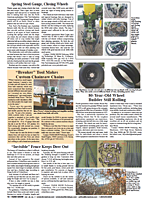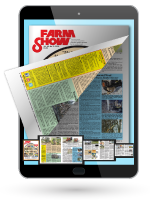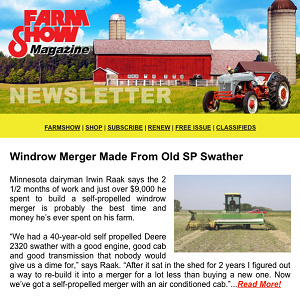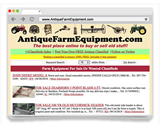World’s Largest Fodder Mill Simplifies Production
The new fully automated, sprouted grain feed mill at Forever Feed Technologies’ (FFT) Innovation Center may be the solution needed by dairy operations in arid regions. The world’s largest such feed mill, it produces a uniform, consistent and fresh feed that improves health, reduces feed intake and increases milk production. It does so with a fraction of the water needed in outdoor production. And it’s simpler and more dependable than other fodder systems. One of the keys is the use of long-proven warehouse automation.
“Our goal was to design a system that was so simple and reliable that it wouldn’t break down,” says Brent Peterson, Forever Feed Technologies. “We dramatically reduced the number of parts needed in an automated fodder system. We use an automatic racking system that’s very durable and has been commonly used for decades.”
The FFT system lays seed on a 4 by 4-ft. pallet that the racking system carries to an open spot in the warehouse. There it’s stored, and the seed is watered. In six days, the seed sprouts and begins to green up as photosynthesis activates in each sprout.
“It’s a very efficient and limited energy system,” says Peterson. “We have no grow lights or belts to move the seed as it sprouts. The ambient light from operating lights in the building is all that the sprouts need.”
At the end of six days, the racking system picks up the pallet and dumps the fodder onto a conveyor belt that carries it to a shredder. The shredded fodder is carried to the feedlot, where it’s measured into the TMR mixer.
Back in the fodder feed mill, the pallet handling system cleans the pallet and reloads it with seed before returning it to its place in the rack.
“The system knows where each of the thousands of pallets are,” says Peterson.
He credits FFT’s design partner, JR Automation, for the knowledge needed to put the system together.
“We understand the science behind growing the fodder suitable for dairy animals,” he says. “They provided the automation expertise needed.”
The Innovation Center is a 10,000-sq. ft. building that can produce about 30,000 lbs. of fodder per day. Approximately one-third the size of a full-scale unit, it’s located at FFT CEO Jack de Jong’s River Ranch Farms, LLC, in Hanford, Calif. Research with the fodder and the dairy herd is evaluating recommended inclusion rates in a ration, as well as evaluating the fodder’s impact on the herd.
“It’s still early yet, but we’re seeing very positive results and capturing the data,” says Peterson. “We’ve tried different percentages of fodder as high as 20%. We expect the sweet spot will be between 10 and 20%.”
Peterson expects the prototype to be duplicated many times over as it proves itself out. The owners of FFT are all dairymen eager to utilize the system.
“Our investor team members all own dairies or other ag facilities,” says Peterson. “Their goal is to develop the technology so they can implement it in their operations.”
Once in full production, each FFT feed mill will produce 100,000 lbs. of fodder per day. That’s enough to provide up to 20% of the feed required by a 2,500 herd of milking cows.
“We’re in the fine-tuning stage with the Innovation Center before building the first full-scale production unit,” says Peterson. “It’s functional now, but there are still little odds and ends that need to be addressed. When you’re feeding dairy cows, you can’t have any downtime. The system has to be totally functional.”
Contact: FARM SHOW Followup, Forever Feed Technologies, 6127 Jackson Ave., Hanford, Calif. 93230 (info@foreverfeed.com; www.foreverfeed.com).

Click here to download page story appeared in.
Click here to read entire issue
World’s Largest Fodder Mill Simplifies Production
The new fully automated, sprouted grain feed mill at Forever Feed Technologies’ (FFT) Innovation Center may be the solution needed by dairy operations in arid regions. The world’s largest such feed mill, it produces a uniform, consistent and fresh feed that improves health, reduces feed intake and increases milk production. It does so with a fraction of the water needed in outdoor production. And it’s simpler and more dependable than other fodder systems. One of the keys is the use of long-proven warehouse automation.
“Our goal was to design a system that was so simple and reliable that it wouldn’t break down,” says Brent Peterson, Forever Feed Technologies. “We dramatically reduced the number of parts needed in an automated fodder system. We use an automatic racking system that’s very durable and has been commonly used for decades.”
The FFT system lays seed on a 4 by 4-ft. pallet that the racking system carries to an open spot in the warehouse. There it’s stored, and the seed is watered. In six days, the seed sprouts and begins to green up as photosynthesis activates in each sprout.
“It’s a very efficient and limited energy system,” says Peterson. “We have no grow lights or belts to move the seed as it sprouts. The ambient light from operating lights in the building is all that the sprouts need.”
At the end of six days, the racking system picks up the pallet and dumps the fodder onto a conveyor belt that carries it to a shredder. The shredded fodder is carried to the feedlot, where it’s measured into the TMR mixer.
Back in the fodder feed mill, the pallet handling system cleans the pallet and reloads it with seed before returning it to its place in the rack.
“The system knows where each of the thousands of pallets are,” says Peterson.
He credits FFT’s design partner, JR Automation, for the knowledge needed to put the system together.
“We understand the science behind growing the fodder suitable for dairy animals,” he says. “They provided the automation expertise needed.”
The Innovation Center is a 10,000-sq. ft. building that can produce about 30,000 lbs. of fodder per day. Approximately one-third the size of a full-scale unit, it’s located at FFT CEO Jack de Jong’s River Ranch Farms, LLC, in Hanford, Calif. Research with the fodder and the dairy herd is evaluating recommended inclusion rates in a ration, as well as evaluating the fodder’s impact on the herd.
“It’s still early yet, but we’re seeing very positive results and capturing the data,” says Peterson. “We’ve tried different percentages of fodder as high as 20%. We expect the sweet spot will be between 10 and 20%.”
Peterson expects the prototype to be duplicated many times over as it proves itself out. The owners of FFT are all dairymen eager to utilize the system.
“Our investor team members all own dairies or other ag facilities,” says Peterson. “Their goal is to develop the technology so they can implement it in their operations.”
Once in full production, each FFT feed mill will produce 100,000 lbs. of fodder per day. That’s enough to provide up to 20% of the feed required by a 2,500 herd of milking cows.
“We’re in the fine-tuning stage with the Innovation Center before building the first full-scale production unit,” says Peterson. “It’s functional now, but there are still little odds and ends that need to be addressed. When you’re feeding dairy cows, you can’t have any downtime. The system has to be totally functional.”
Contact: FARM SHOW Followup, Forever Feed Technologies, 6127 Jackson Ave., Hanford, Calif. 93230 (info@foreverfeed.com; www.foreverfeed.com).
To read the rest of this story, download this issue below or click
here to register with your account number.








